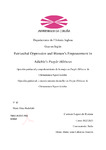Mostrar o rexistro simple do ítem
Patriarchal Oppression and Women’s Empowerment in Adichie’s Purple Hibiscus
| dc.contributor.advisor | Frías Rudolphi, María | |
| dc.contributor.author | López de Ramón, Carmen | |
| dc.contributor.other | Universidade da Coruña. Facultade de Filoloxía | es_ES |
| dc.date.accessioned | 2023-11-28T12:43:41Z | |
| dc.date.available | 2023-11-28T12:43:41Z | |
| dc.date.issued | 2022 | |
| dc.identifier.uri | http://hdl.handle.net/2183/34358 | |
| dc.description.abstract | [Abstract] The purpose of this paper is to provide an analysis of the famous novel Purple Hibiscus (2003) by the writer Chimamanda Ngozi Adichie. Two main issues will be discussed: the subject of patriarchal societies and the women empowerment movement, both represented by different characters of the novel, Eugene and Ifeoma. The common factor combining these two opposite ideas will be the character of Kambili. This paper will provide an analysis on the evolution and change she suffers and how it affects her and her family. It will also discuss main issues that are present nowadays such as the salary gap between men and women and the difficulties the latter have to achieve certain jobs in some professional fields. This essay will also cover some controversial issues much discussed in society, such as religion, traditions and the confrontation between the two of them may bring to certain people. It will also deal with, and question, two opposite concepts of family represented by two different characters to later refer to the gender differences and stereotypes women suffered in Nigeria in the mid-eighties- at the time the story took place but that are still a problem in today’s society throughout the world. In this paper, through Kambili’s eyes, concerning society issues, very present nowadays, will be narrated by an innocent voice and from the perspective of a young girl. However, not only the reader will discover Kambili’s personality but also her brother’s Jaja and numerous cousins- such as Amaka- since all of them play a relevant role in the process of awakening Kambili. Each character of Adichie’s writing helps to get acquainted with various and opposite ways of seeing life. Also, Kambili’s slow development can be appreciated as the story unfolds in front of the reader. She grows and overcomes many fears and situations that are very difficult to anyone, especially for a little girl. | es_ES |
| dc.language.iso | eng | es_ES |
| dc.rights | Os titulares dos dereitos de propiedade intelectual autorizan a visualización do contido deste traballo a través de Internet, así como a súa reproducción, gravación en soporte informático ou impresión para o seu uso privado e/ou con fins de estudo e de investigación. En nengún caso se permite o uso lucrativo deste documento. Estos dereitos afectan tanto ó resumo do traballo como o seu contido Los titulares de los derechos de propiedad intelectual autorizan la visualización del contenido de este trabajo a través de Internet, así como su repoducción, grabación en soporte informático o impresión para su uso privado o con fines de investigación. En ningún caso se permite el uso lucrativo de este documento. Estos derechos afectan tanto al resumen del trabajo como a su contenido | es_ES |
| dc.subject | Patriarchy | es_ES |
| dc.subject | Domestic violence | es_ES |
| dc.subject | Nigerian women | es_ES |
| dc.subject | Religion | es_ES |
| dc.subject | Family secrets | es_ES |
| dc.subject | Women’s empowerment | es_ES |
| dc.subject | Adichie, Chimamanda Ngozi | es_ES |
| dc.title | Patriarchal Oppression and Women’s Empowerment in Adichie’s Purple Hibiscus | es_ES |
| dc.title.alternative | Opresión patriarcal y empoderamiento de la mujer en Purple Hibiscus de Chimamanda Ngozi Adichie | es_ES |
| dc.title.alternative | Opresión patriarcal e empoderamento da muller en Purple Hibiscus de Chimamanda Ngozi Adichie | es_ES |
| dc.type | info:eu-repo/semantics/bachelorThesis | es_ES |
| dc.rights.access | info:eu-repo/semantics/openAccess | es_ES |
| dc.description.traballos | Traballo fin de grao (UDC.FIL). Inglés: estudios lingüísticos y literarios. Curso 2021/2022 | es_ES |






